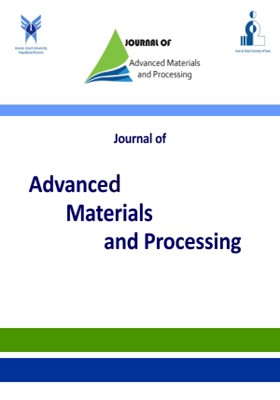The Study of High Temperature Oxidation behavior of Different Microstructures of HVOF Thermally Sprayed Coatings
الموضوعات :Behnaz Saeedi 1 , Alireza Rouhaghdam 2
1 - PhD student
2 - Associate Professor
الکلمات المفتاحية: High temperature corrosion, Coatings, Thermal spray, Ni-based alloy,
ملخص المقالة :
Improvement of thermally sprayed coating properties by microstructure modification has been considered as a significant solution. Therefore, in this research the effect of dissolved oxygen content and post heat treatment on the formation and distribution of secondary phase particles, particularly in nano-scale in the coatings during spraying and after that were studied. Ni-5 wt% Al powders were sprayed by high velocity oxy-fuel (HVOF) technique under two different oxygen/fuel ratio to achieve different melting state for feedstock materials. As-sprayed coatings were exposed to complementary heat treatment including heating at 1100 °C under inert atmosphere, then furnace cooling to room temperature. As-sprayed and heat treated coatings were evaluated for high temperature performance. Isothermal oxidation tests were made at 950 °C for 100 h. The results showed that dependent on spraying condition and optimization of the coating microstructure, Ni-based sprayed coatings with low Al content could be utilized as an efficient bond coat or overlay coating.
- F.S. Pettit, “Oxidation mechanisms for Nickel-Aluminum alloys at temperatures between 900 °C and 1300 °C, Trans. Metall. Soc. Aime, Vol. 239, 1967, pp. 1296-1305.
- D. F. Susan, A. R. Marder, “Oxidation of Ni–Al-base electrodeposited composite coatings. I: oxidation kinetics and morphology at 800°C”, Oxid. Met., Vol. 57, No. 1/2, 2002, pp. 131-157.
- J. Saaedi, T. W. Coyle, H. Arabi; S. Mirdamadi, J. Mostaghimi, “Effects of HVOF process parameters on the properties of Ni-Cr coatings”, J. Therm. Spray Tech., Vol. 19, No. 3, 2010,
pp. 521-530. - C. M. Hackett, G. S. Settles, “The Influence of nozzle design on HVOF spray particle velocity and temperature”, Proc. 8th National Thermal Spray Conference, Houston, Texas, 1995, p. 11.
- W. Brandl,D. Toma, J. Kruger, H. J. Grabke, G. Matthause, “The oxidation behaviour of HVOF thermal-sprayed MCrAlY coatings, Surf. Coat. Techol., Vol. 94-95, 1997, pp. 21-26.
- S. Deshpande, T. S. Sampath, H. Zhang,“Mechanisms of oxidation and its role in microstructural evolution of metallic thermal spray coatings-Case study for Ni–Al”, Surf. Coat. Technol., Vol. 200, 2006, pp. 5395-5406.
- J. Y. Cho, S. H. Zhang, T. Y. Cho, J. H. Yoon, Y. K. Joo, S. K. Hur, “The processing optimization and property evaluations of HVOF Co-base alloy T800 coating”, J. Mater. Sci., Vol. 44, 2009, pp. 6348–6355.
- G. Bolelli, L. Lusvarghi, M. Barletta, “Heat treatment effects on the corrosion resistance of some HVOF-sprayed metal alloy coatings”, Surf. Coat. Technol., Vol. 202, 2008,
pp. 4839–4847. - P. Fauchais, A. Vardelle, B. Dussoubs, “Quo Vadis Thermal Spraying?”, J. Therm. Spray Tech., Vol. 10, No. 1, 2001, pp. 44-66.
10. G. Zhang, A. F. Kanta, W. Y. Li, H. Liao, C. Coddet, “Characterizations of AMT-200 HVOF NiCrAlY coatings”, Mater. Design, Vol. 30, 2009, pp. 622–627.
11. B. Saeedi, A. Sabour, A. M. Khodami, “Study of microstructure and thermal shock behavior of two types of thermal barrier coatings”, Mater. Corros., Vol. 60, No. 9999, 2009, pp. 1-8.
12. C. Suryanarayana, M. G. Norton, X-Ray Diffraction: A Practical Approach, Springer Science+Business Media, New York 1998.
13. G. Bolelli, L. Lusvarghi, R. Giovanardi, “A comparison between the corrosion resistances of some HVOF-sprayed metal alloy coatings”, Surf. Coat. Technol., Vol. 202, 2008,
pp. 4793–4809.
14. M. J. Donachie, S. J. Donachie, Superalloys: A Technical Guide, ASM International, Materials Park, OH, 2002.
15. S. Matthews, M. Hyland, B. James, “Microhardness variation in relation to carbide development in heat treated Cr3C2–NiCr thermal spray coatings”, Acta Mater., Vol. 51, 2003,
pp. 4267–4277.
16. B. G. Mendis, B. Tryon, T. M. Pollock, K. J. Hemker, “Microstructural observations of as-prepared and thermal cycled NiCoCrAlY bond coats”, Surf. Coat. Technol., Vol. 201, 2006,
pp. 3918–3925.
17. E. Copland, “Solidification behavior of γ’-Ni3Al-containing alloys in the Ni–Al–O system”, Acta Mater., Vol. 55, 2007,
pp. 4853-4865.
18. Ch. Kuo, W. D. Jehng, Sh. Hsieh, Ch.Chen, “Phase equilibria on Ni–Al interface under low oxygen pressure”, J. Alloy. Compd,Vol. 480, 2009, pp. 299–305.
19. T. J. Nijdam, L. P. H. Jeurgens, J. H. Chen, W. G. Sloof, “On the Microstructure of the Initial Oxide Grown by Controlled Annealing and Oxidation on a NiCoCrAlY Bond Coating”, Oxid. Met., Vol. 64, No. 5/6, 2005, pp. 355-377.
20. W. R. Chen, X. Wu, B. R. Marple, R. S. Lima, P.C. Patnaik, “Pre-oxidation and TGO growth behaviour of an air-plasma-sprayed thermal barrier coating”, Surf. Coat. Technol. Vol. 202, 2008, pp. 3787-3796.
21. D. Toma, W. Brandl, U. Köster, “The Characteristics of alumina scales formed on HVOF-sprayed MCrAlY coatings”, Oxid. Met., Vol. 53, No. 1/2, 2000, pp. 125-137.
22. V. V. Sobolev, J. M. Guilemany, “Flattening of droplets and formation of splats in thermal spraying: a review of recent work-part 1”, J. Therm. Spray Techn., Vol. 8, No. 1, 1999,
pp. 87-101.


